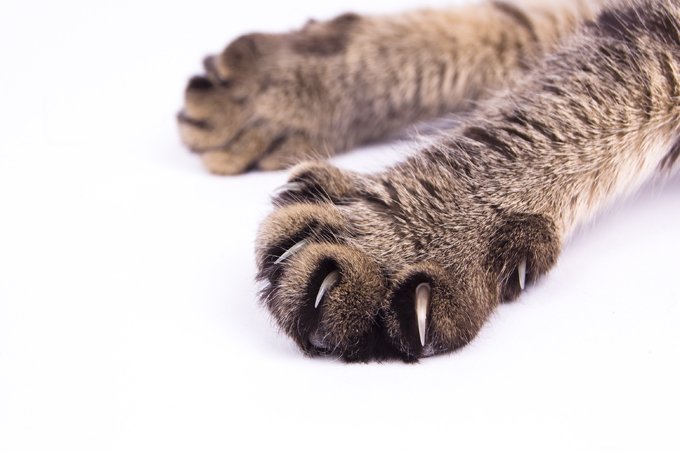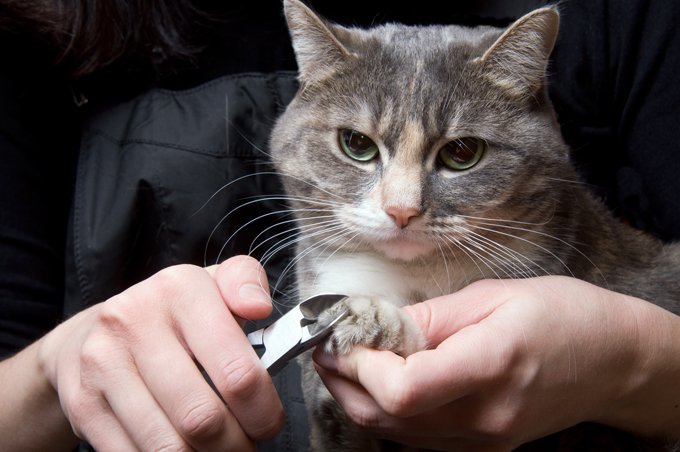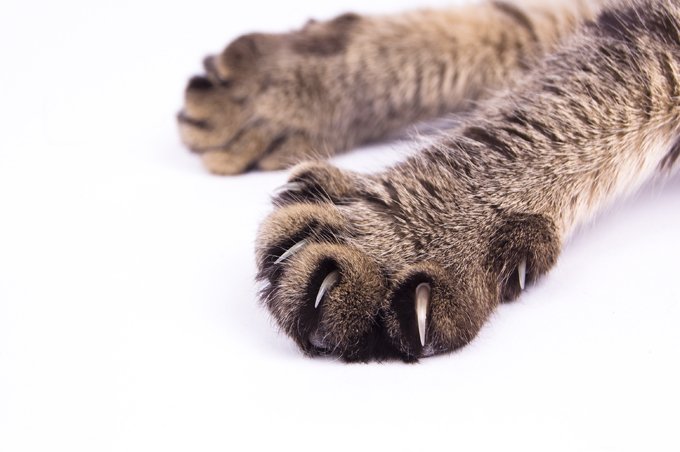Cat owners may have moments when they’re happily playing with their cat or reaching out to rub their cat’s belly when kitty unsheathes her super sharp claws and leaves a long gash in her wake. The “cat surprise attack” can be quite painful!
What do you do to prevent this from happening? Declawing is not an option because the surgery amputates the last bone on each cat’s toe and leaves the cat in a lot of pain, with possible behavior problems down the line. Your three main options are clipping your cat’s nails, capping them, or just leaving them a natural length. Here are the pros and cons of each.
Clipping Claws
Clipping the tips of your cat’s claws has a lot of advantages. First, your cat won’t be able to destroy your favorite furniture! If your cat loves to knead you, she won’t scratch you up in the process. Keeping your cat’s nails short can also prevent your cat from painfully breaking her nails if her claws get caught in the carpet or your furniture.
If you have more than one cat in your household, make sure you don’t just clip one cat’s claws. A downside of clipping is that it can leave one cat less able to defend herself against a cat that doesn’t have clipped nails. And if your cats ever go outside, it can make climbing trees or escaping aggressive animals more difficult.
Clipping your cat’s claws can be stressful to your cat if not done right. To diminish the stress, buy a pair of rounded clippers made specifically for cats. Hold your cat gently in your lap and keep a bag of treats handy. Take one paw in your hand and squeeze her toe pad until her claw extends. Clip just the end of the claw, being careful to avoid the pink part where nerves and blood vessels can be painfully sensitive. If kitty gets stressed, pause and start again later.
Capping Nails
If your cat is prone to damaging your furniture – or you – then you may need to cap her nails instead of just trimming them. Capping doesn’t end the need to trim your cat’s nails entirely, but it reduces how many times you need to do so. Capped nails can last six to eight weeks and fall off naturally as your cat’s nails grows. This means you may only need to trim your cat’s nails every six weeks rather than every two to three weeks without caps. Another plus is that the caps won’t prevent your cat from extending and retracting her claws, which can be a big source of stress relief for kitty.
Caps come in a variety of colors and designs and can look really cute on your cat, but they do have their downsides. Just like with clipped nails, you don’t want to leave kitty outside if she has caps. And you don’t want to leave one cat in your household with caps on and one cat without, as this can leave your capped cat defenseless.
Applying the caps is a fairly simple process. Apply the glue to the inside of the caps first and then place one cap on each extended claw. Hold kitty’s paws still while the glue dries, which should only take a few seconds. Many cats won’t notice caps after you’ve applied them, but keep an eye out for a sensitive kitty who just doesn’t get used to them.
Leaving a Full Length Claw
Sometimes, the best option for your cat is leaving her nails full length. If your cat uses her scratching posts enough to keep her nails short, clipping might not be necessary. And if clipping or capping is just really stressful for your cat, you might be better off avoiding the stress.
If your cat’s not destroying your furniture or you, then you might not need to worry too much about nail length. In addition, many cat owners can train their cats to be less destructive by setting up a lot of scratching posts around the house as alternatives to furniture. You can also apply CatTime’s top five techniques for curbing bad behavior and use these to teach kitty not to use her claws as a destructive force.
Deciding whether to “clip, cap, or claw” is really up to you. In most cases, clipping or capping are good choices for your cat’s health, but this may not always be the case for anxious or sensitive cats. If you choose to let your cat’s nails stay full length, keep a close eye on kitty to make sure her nails don’t get caught on anything or become ingrown.











